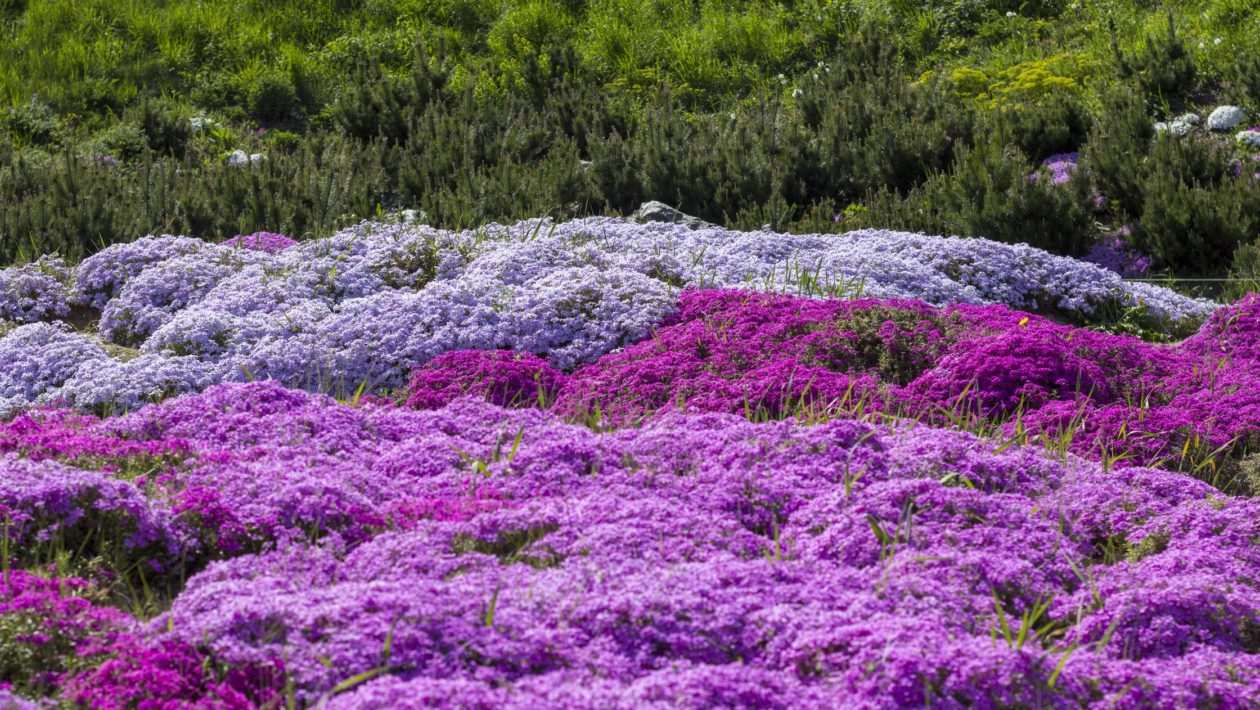To cultivate creeping phlox at first, it’s essential to know what creeping phlox is. Not only that, but you also have to acquire some basic knowledge about creeping phlox, including its habitat and anatomical features. If you don’t know its unique qualities then you will face problems to grow it. Here in this whole article, I have included the elements of creeping phlox. Again when and how it can be beneficial to increase, all these are also discussed.
The genus name of Creeping phlox is “phlox.” It is derived from the Greek word that means “flame.” It signifies the intense color of its flowers. Mainly, Creeping phlox is a familiar spring-blooming creeping plant. It is frequently seen in a rocky area or growing cracks in stone walls. Even it can be planted as a flowering ground. It’s most prominent feature is its flower color. After blooming, the tiny leaves remain green for all year-round. The flowers are densely packed, that it’s hard to make out the plants foliage from a distance. In easy words, I can say creeping phlox is a low growing, easy-going green perennial plants. These grow happily in challenging places. In the rocky garden, it’s a suitable option to bring a splash of variant color. As a result, it gives life to a rocky garden.
Table of Contents
It’s a Perennial herb with the green color specification. Creeping phlox color specifications can be white, pink, and purple. Its blooming time is from March to June.
Not only the gardener but also Native Americans are also a fan of these plants. They named it “April’s full Moon,” that implies “full pink Moon.” Its flower has a specialty. When its flower blooms, it shows purple and pink color. Thus it signifies the arrival of spring.
Here I have explained the features of Creeping phlox under some specific categories-
Habitat: Sometimes, creeping phlox are also called “Moss pink” or “Moss phlox.” It mainly depends on the growth habit. Often it’s listed as an herbaceous perennial. Though it’s a semi-evergreen and related to the family “Phlox.”
Length: The plants can reach up to 6 inches in height and can spread out up to 2 feet to form a mat. It’s fully exposed to sunray. Its central blooming time is spring.
Color: There are many color variations of creeping phlox. It includes pink, red, white, blue, rose, lavender, and purple.
Species: There are some species of creeping phlox. These are P. stolonifera and P. Subtulata. These two varieties originate from North America. The two most common types of P. Stolonifera are “blue ridge” and “pink ridge.” Its white type is known as “Bruce’s White.” It’s so much popular among gardeners. There are also P. Bifida and P. nivalis. These are also another two types of phlox. But these two types are not as colorful as P. subtlety.
Act against Natural calamities: These colorful low growing plants help to prevent erosion. Thus it makes the soil formation a perfect growing place on sensitive areas, including slopes. Creeping Phlox also acts as a plant blanket with its vibrant color.
Which one is suitable for cultivation?
Technically, P. stolonifera is a creeping phlox where P. Subulata is a moss phlox. But they both have similarities in basic appearance as well in biologically. These two are also favorite to the gardener as many people interchange these two species unconsciously due to having some similarities. These two types have semi-evergreen ground, and both flower bloom in spring.
Again they have many differences such as P. Subtulata only reaches the height of 6 inches, where P. stolonifera can grow to around with a height of 12 inches.
- Subtulata has more needle-like leaves where p. stolonifera has more of mixed foliage.
But the main difference is found in the color of these two species. P. stolonifera has partial shade, where P. Subtulata is very much sun seeker. P. Subtulata only flourishes in full sunlight.
But if you want to choose one between these two, then I will say P. Subtulata is more preferable. For its vibrant color, its also known as “candy stripe.” As it’s shorter in height and tends to bloom more densely. But both of these types are beautiful if one can plant this under favorable conditions.
How to grow Creeping Phlox:
Creeping phlox is one of the best perennials plants that one can proliferate in sunny areas. But advancing phlox care is also an essential matter for profitable growth. It requires minimal maintenance, less amount of water, a bit of seasonal pruning, and even an annual feeding.
Here I have mentioned some essential growing tips. This mainly includes some specific Growing conditions. These are as follows-
- It requires high water maintenance.
- It requires full sun or partial shade. But the fully sunny environment is better than a partially shady area.
- It requires less amount of moisture.
- For proper growth, its pH balance has to maintain. Soil pH has to keep more than 6.8. That implies Acidic type of soil is better for its’s proper growth.
- The soil type for this herb is dry, sandy, and rocky soils.
Now, Some factor one should maintain during cultivating creeping phlox are as follows-
Proper land selection: One should choose a place that will cover a sunny area. As creeping phlox plants stay short and spread quickly, covering the ground area. The landlords having flat land can grow creeping phlox to protect their ground. It can form plant borders along with lawns or walkways. Especially when this is planted in the spring season in slopes, it seems much beautiful.
Propagation of Creeping Phlox: To propagate creeping phlox plants, you have to first divide them after the spring season. The proper time is just after they have finished blooming. Then dig up the entire plant including the root ball. Then cut through the roots to divide the plants roughly in half then plant each half as desired. Generally, it’s fine to divide a land every two to three years for preventing significant damage.
Some quick steps for propagation:
- Propagation is done by dividing or cutting the bud after blooming.
- No seed collection is required for this herb growth.
- Its bud is commercially available.
Soil: Creeping phlox plants need evenly moist soil. But one has to make sure about the amount of humus and compost present in the soil. This helps to grow in good condition. So clay soil is far better for cultivating a good quality creeping phlox. But even in the poorest soil conditions, this plant spreads quickly. For preventing soil erosion, these herbs have to distribute evenly.
Light: Lighting factor for creeping phlox varies species to species. A place or a slope facing in the southern direction is ideal for growing perennial plants. It helps to grow best in full sun. So creeping phlox is not exceptional regarding this matter. An adequate amount of light is required for the proper growth of creeping phlox.
Cleaning weeds: Grass and weeds growing up through the plant can be major trouble. It’s best to start managing weeds early in the season. The perfect time for weeding is when the phlox blooms or its foliage is at its fullest. Hand pulling is the most effective way. Later it’s important to lift the phlox at the edges as needed to reach the base of the weeds. Again, it’s essential to pull out the roots.
Water: Watering is the most important issue for any plant. Creeping phlox needs less watering. Weekly watering helps grow creeping phlox during the summer season. Though creeping phlox has a drought-tolerant specialty than many other phlox plants. So, you need to maintain a little bit with care to grow them fully.
Temperature:
The creeping perennial can tolerate a hot environment. The atmosphere surrounded by rocks, gravel or path surfaces can be tolerated by creeping phlox.
Humidity: The important thing is that creeping phlox does not require high humidity. It can manage dryness. So it’s easy to cultivate than many other phlox plants.
Fertilizer: Creeping phlox in winter or early spring promotes growth and supports a more healthy bloom. It requires less amount of fertilizer. The application of fertilizer at an early stage helps to develop the growth of the creeping phlox.
Trimming and pruning:
Pruning of creeping phlox is an optional matter. After the blooming period, you can trim each the foliage to create a neater form. A gardener can let it spread naturally in a wide area. Thus it can cover a larger area. Again trimming it due to proper time is also an important factor. Trimming is done to maintain a neater or smaller form. It can enhance plant beauty. Again you can skip pruning and let the plants grow naturally. Sometimes trimming can result in a second bloom.
Proper care: If you neglect pulling out the weeds, then it will be harmful to proper growth. So clearing the surface is so much essential for phlox. If it’s not rainy season and it rains once then you have to water regularly. In the spring season, put a thin layer of compost and a 2-inch layer of mulch around the plants. It will keep the soil moist and will control the weeds.
Pest control: For pest control, it’s important to take initiatives. It will prevent the plant from pest infection and provide a healthy growth of this perennial herb. For this herb, powdery mildew, stem canker, rust, southern nematodes, leaf spots, leaf miners and caterpillars are the most common types of diseases caused by pest.
Some tips for cultivation:
For planting here are some tips. These will help you to grow creeping phlox according to your preference-
- It’s easy to grow phlox from cuttings and transplants rather than using seeds. So, it’s good that creeping phlox seeds are not required for growth.
- Loose the soil and dig up to 12 to 15 inches deep.
- Then mix a 2 to 4-inch layer of compost with the soil.
- It’s best to plant phlox in spring. With a space of 1 to 2 feet apart, place the cuttings of plant.
- This herb has very adaptable and versatile features. So, with less maintenance and the right amount of sun exposure, you can grow it easily.
- Prevent to grow in soggy soil. So, the proper amount of water is important for its growth. Use a garden fork and tiller to prepare your garden bed.
- If you shift a plant from a pot then dig a hole about twice the size of the pot’s diameter. Then place the plant so that the top of the root ball is even with the surface of the soil.
- Fill the around surface of the root ball and water it thoroughly.
- In general, phlox need a planting site with rich, evenly moist, well-drained soil.
- It’s also important to remove the dead and faded flowers so that plants can bloom again.
- If you grow tall phlox then cut the stems back to about 1 to 2 inches above the soil level.
- Divide the gardens every 2 to 3 years to ensure healthy and disease-free plants.
In this whole article, I have mentioned the types of creeping phlox and how to grow with proper tips & tricks. And if you are a beginner or fond of gardening, then this article will help you. Through this article, you will gather knowledge about creeping phlox and its overall cultivation process. So, now waiting for what? Let’s make your land colorful by growing creeping phlox.
FAQ:
-
How long it takes for a blooming flower?
It takes approximately six weeks in spring and the summer season, it blooms evenly.
-
What other type’s plants I can grow besides creeping phlox?
Some perennial herbs such as ornamental grasses, coreopsis, and Agastache are suitable to plant beside this herb.
-
How far creeping phlox can spread in an area?
The plants reach at most 6 inches and it can spread up to 2 feet to form a mat.
-
Where will I get creeping phlox for sale?
You can collect from the garden or also can purchase creeping phlox seeds from online.





